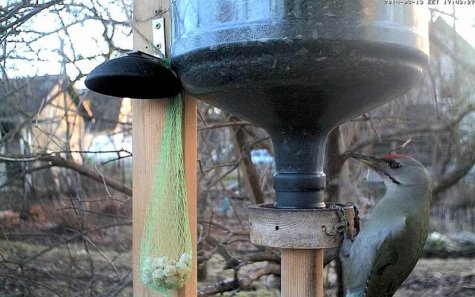Winter bird feeder webcam – grey-headed woodpecker
Web camera image Bea, LK forum
Translation: Liis
Grey-headed woodpecker Hallpea-rähn or hallrähn Picus canus
Together with Arne we decided that we would go on in the spring-winter weather and snowfall with the winter bird feeder camera – perhaps new visitors would still show up …
In urban parks and old cemeteries it is no surprise to meet the grey-headed woodpecker. Often enough it is believed, from the colour of the plumage, that it is a green woodpecker – more than 3000 grey-headed woodpecker pairs may nest in Estonia, but meeting the green woodpecker on the mainland is a rarity for a true bird enthusiast. Only on Saaremaa in the deciduous forests bordering to cultured landscapes some 50 green woodpecker may still breed. Both species are mainly sedentary birds.
The grey-headed woodpecker is up to thirty centimetres long and weighs up to 150 grams – for comparison they are about a quarter larger than the better-known great spotted woodpecker. Head feathers are grey, a black streak between the eyes, on the chin also a narrow black streak resembling sideburns. The plumage of young birds is slightly lighter. The forehead is red only on the males. All have a red eye iris, beak dark grey and legs yellowish grey.
From a successful photo it is easy to describe the bird, but much more difficult to notice in nature – we have to do with an extremely cautious species. If you notice a bird in action, the grey-head often moves into hiding behind the trunk and goes on with its business there. You try to move quietly to a new position but the same process is repeated … A quite difficult subject for photographers: LINK









